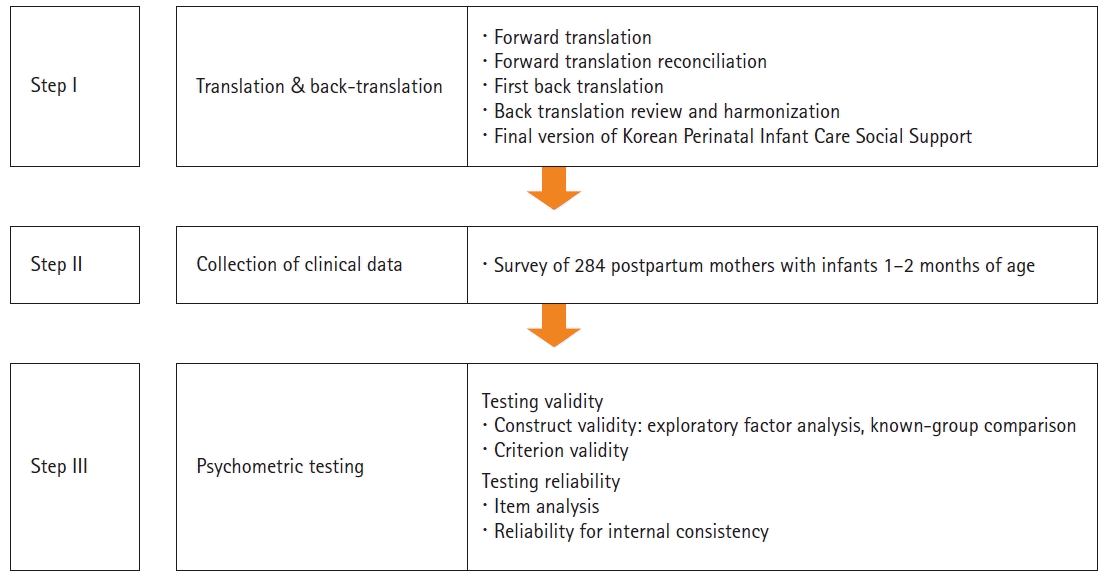3. Leahy-Warren P, McCarthy G, Corcoran P. Postnatal depression in first-time mothers: prevalence and relationships between functional and structural social support at 6 and 12 weeks postpartum. Arch Psychiatr Nurs. 2011; 25(3):174–184.
https://doi.org/10.1016/j.apnu.2010.08.005.

5. Castle H, Slade P, Barranco‐Wadlow M, Rogers M. Attitudes to emotional expression, social support and postnatal adjustment in new parents. J Reprod Infant Psychol. 2008; 26(3):180–194.
https://doi.org/10.1080/02646830701691319.

6. Feligreras-Alcalá D, Frías-Osuna A, Del-Pino-Casado R. Personal and family resources related to depressive and anxiety symptoms in women during puerperium. Int J Environ Res Public Health. 2020; 17(14):5230.
https://doi.org/10.3390/ijerph17145230.

7. Vaezi A, Soojoodi F, Banihashemi AT, Nojomi M. The association between social support and postpartum depression in women: a cross sectional study. Women Birth. 2019; 32(2):e238–e242.
https://doi.org/10.1016/j.wombi.2018.07.014.

10. Heo SH, Noh YG. Impact of parenting stress and husband’s support on breastfeeding adaptation among breastfeeding mothers. Korean J Women Health Nurs. 2017; 23(4):233–242.
https://doi.org/10.4069/kjwhn.2017.23.4.233.

11. Oh EJ, Kim HY. Factors influencing unmarried mothers’ parenting stress: based on depression, social support, and health perception. Korean J Women Health Nurs. 2018; 24(2):116–125.
https://doi.org/10.4069/kjwhn.2018.24.2.116.

12. Park KY, Lee SO. A comparative study on the predictors of depression between primipara and multipara at postpartum 6 weeks. J Korean Soc Matern Child Health. 2011; 15(1):25–36.
https://doi.org/10.21896/jksmch.2011.15.1.25.

14. Kim KS, Kam S, Lee WK. The influence of self-efficacy, social support, postpartum fatigue and parenting stress on postpartum depression. J Korean Soc Matern Child Health. 2012; 16(2):195–211.
https://doi.org/10.21896/jksmch.2012.16.2.195.

19. Park JW. A study to development a scale of social support [dissertation]. Seoul: Yonsei University;1985. 127.
21. Kim SH, Noh YG. Influence of spousal support on the relationship between acculturative stress and sense of parenting competence among married vietnamese immigrant women. Korean J Women Health Nurs. 2018; 24(2):174–184.
https://doi.org/10.4069/kjwhn.2018.24.2.174.

22. Park SE, Bang KS. Correlations among working mothers’ satisfaction with non-maternal infant care, social support from others, and parenting efficacy. J Korean Soc Matern Child Health. 2019; 23(1):23–34.
https://doi.org/10.21896/jksmch.2019.23.1.23.

23. Negron R, Martin A, Almog M, Balbierz A, Howell EA. Social support during the postpartum period: mothers’ views on needs, expectations, and mobilization of support. Matern Child Health J. 2013; 17(4):616–623.
https://doi.org/10.1007/s10995-012-1037-4.

25. McDaniel BT, Coyne SM, Holmes EK. New mothers and media use: associations between blogging, social networking, and maternal well-being. Matern Child Health J. 2012; 16(7):1509–1517.
https://doi.org/10.1007/s10995-011-0918-2.

27. Kang H. Discussions on the suitable interpretation of model fit indices and the strategies to fit model in structural equation modeling. J Korean Data Anal Soc. 2013; 15(2):653–668.
28. Beavers AS, Lounsbury JW, Richards JK, Huck SW, Skolits GJ, Esquivel SL. Practical considerations for using exploratory factor analysis in educational research. Pract Assess Res Eval. 2013; 18(6):1–8.
https://doi.org/10.7275/qv2q-rk76.

30. Choi Y, Choi SH, Yun JY, Lim JA, Kwon Y, Lee HY, et al. The relationship between levels of self-esteem and the development of depression in young adults with mild depressive symptoms. Medicine (Baltimore). 2019; 98(42):e17518.
https://doi.org/10.1097/MD.0000000000017518.

31. Cox JL, Holden JM, Sagovsky R. Detection of postnatal depression. Development of the 10-item Edinburgh Postnatal Depression Scale. Br J Psychiatry. 1987; 150:782–786.
https://doi.org/10.1192/bjp.150.6.782.

32. Kim YK, Hur JW, Kim KH, Oh KS, Shin YC. Clinical application of Korean version of Edinburgh postnatal depression scale. J Korean Neuropsychiatr Assoc. 2008; 47(1):36–44.
33. Choi Y, Moon H. The effects of parenting stress, parenting efficacy, spouse support and social support on parenting behavior of mothers with infant children. Early Child Educ Res Rev. 2016; 20(6):407–424.
34. Slomian J, Emonts P, Vigneron L, Acconcia A, Glowacz F, Reginster JY, et al. Identifying maternal needs following childbirth: a qualitative study among mothers, fathers and professionals. BMC Pregnancy Childbirth. 2017; 17(1):213.
https://doi.org/10.1186/s12884-017-1398-1.

35. Vargas-Porras C, Roa-Díaz ZM, Ferré-Grau C, De Molina-Fernández MI. Psychometric properties of the functional social support domain of perinatal infant care social support. Invest Educ Enferm. 2020; 38(2):e4.
https:// doi.org/10.17533%2Fudea.iee.v38n2e04.

37. Almalik MM. Understanding maternal postpartum needs: A descriptive survey of current maternal health services. J Clin Nurs. 2017; 26(23-24):4654–4663.
https://doi.org/10.1111/jocn.13812.

38. Shorey S, Chan SW, Chong YS, He HG. Maternal parental self-efficacy in newborn care and social support needs in Singapore: a correlational study. J Clin Nurs. 2014; 23(15-16):2272–2282.
https://doi.org/10.1111/jocn.12507.

39. Yu JO, June KJ, Park SH, Woo MS. Content analysis of mothers’ questions related to parenting young children in internet parenting community. J Korean Soc Matern Child Health. 2020; 24(4):234–243.
https://doi.org/10.21896/jksmch.2020.24.4.234.






 PDF
PDF Citation
Citation Print
Print



 XML Download
XML Download